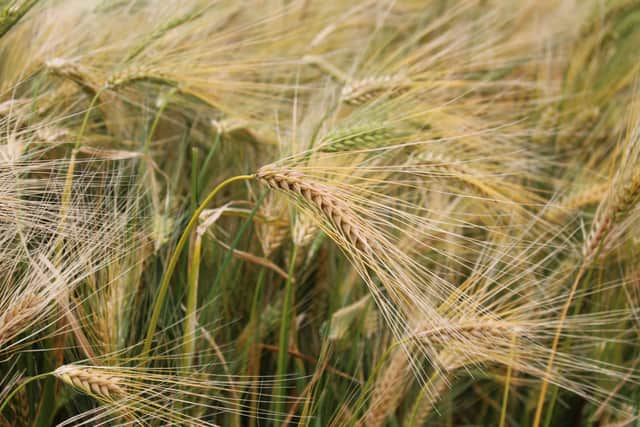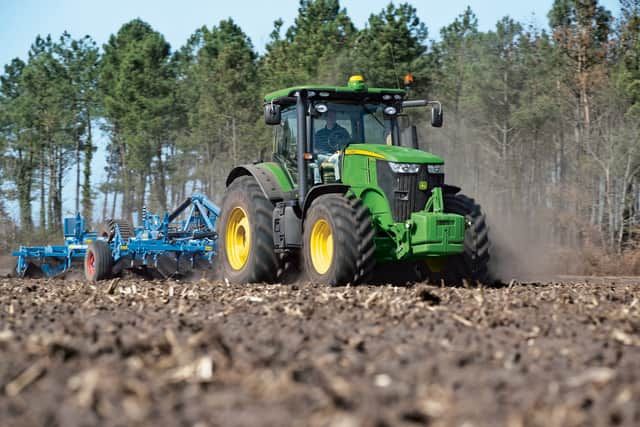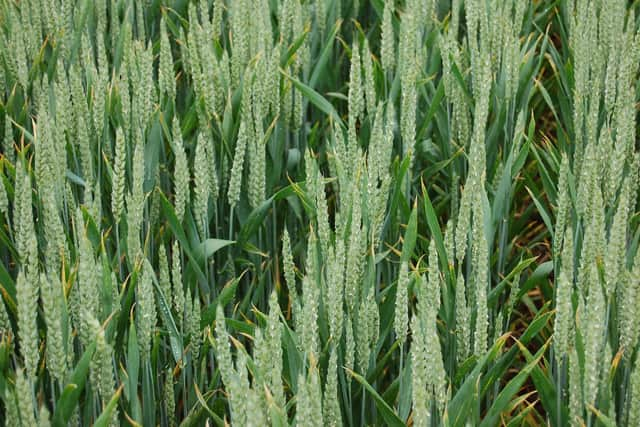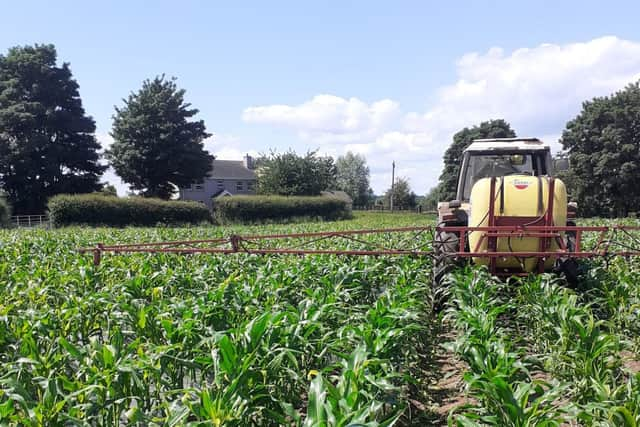The case for increasing NI’sarable sector is undeniable
and live on Freeview channel 276
And it really is a case of every little bit helping the cause. For me, at least, it is now obvious that local agriculture will have to become as self sufficient as possible, when it comes to determining its own future.
And part of this strategy will include the growing of more grain and protein crops. Relying, almost totally, on supplies of abroad could be a risky strategy into the long term.
Advertisement
Advertisement
Undoubtedly, the deal struck over the past few days, to allow the shipment of grain and oilseeds from three of Ukraine’s Black Sea ports will help ease the supply:demand pressures that have been developing around the world, where grains and oilseeds are concerned.


World grain markets have eased in the wake of the Russia:Ukraine ‘safe passage for grain’ agreement. And Monday of this week saw the first, fully laden boat make its way out of Odesa harbour, headed for a destination in North Africa.
But one boat counts for very little in the grand scheme of things. It is yet to be seen if a trickle of grain now, becomes a flood later in the autumn.
But international markets work, to a large extent, on sentiment. One good thing that has already come out of recent developments is the easing of fears that grain products might actually be rationed for animal feed consumption purposes next winter.
Advertisement
Advertisement
Moreover, the exacting costs of insurance associated with the transport of cereals and oilseeds from Ukraine, will help to ensure that global rain markets will not fall back that significantly over the coming weeks and months.


But it is to the prospects for the year ahead that many international grain analysts are now turning their attention.
The reality is that Ukraine’s domestic grain markets have crashed, raising the prospect that farmers in the country will not have the funds to plant-out crops for the 2022/23 season.
Masha Belikova, a senior grain analyst with Fast Markets, an international grain market news agency, commented:“Not being able to get grain out of the Ukraine lies at the heart of the problem.
Advertisement
Advertisement
“Currently, 6.5m tonnes of last year’s wheat crop and 9m tonnes of 2021 corn remains in store across Ukraine, either on-farm or in facilities owned by domestic grain buying operations.”


She continued:“All this product is now overhanging the market.”
According to Belikova, the solution to this problem centres on the agreement reached by Ukraine and Russia last week, which would allow the safe passage of grain from Romania’s Black Sea ports, being enacted with immediate effect.
She said:“The ending of the war is another option. But that’s unlikely to happen in the near future.
Advertisement
Advertisement
“There are large numbers of boats fully laden with grain that have been unable to leave Odessa since the outbreak of the war.


“Getting access to world markets for Ukrainian grain is the only way that the country’s farmers can access the much stronger international markets and funds for cereals and oilseeds.”
But if this cannot be achieved, a support fund will have to be developed to allow grain growers in Ukraine access the finance they need to plan for next year.
“The authorities in Kiev are already talking to banks and other governments around the world with this objective in mind,” confirmed Belikova.
Advertisement
Advertisement
According to the Dnipro-based analysts, approximately 11m tonnes of grain have been harvested by farmers in Ukraine over recent weeks. The breakdown is as follows: 8m tonnes of wheat plus 3m tonnes of other cereals.
“The wheat figure accounts for 46% of the total land area dedicated to that cereal crop in 2022,” Belikova further explained.
“Yields are down, year-on-year, because of the drought conditions experienced across most of Ukraine’s grain growing regions over recent months.”
She continued:“Obviously, the land occupied by the Russian army was not planted out this year. Fires over recent weeks, caused by the continuing conflict, have also served to reduce the total amount of grain that will be harvested in 2022.”
Advertisement
Advertisement
Belikova concluded:“In total contrast corn crops across Ukraine are looking very well at the present time. There is now the genuine prospect that the total corn harvest could come in at 27m tonnes.”
While the attention of the world has quite rightly, been focussed on Ukraine over recent weeks and months, it has gone somewhat unnoticed that most of Eastern Europe has been impacted by the worst drought in living memory.
Initial reports are indicating that wheat yields in Romania have fallen by 43%, year-on-year.
Eastern Europe plays a critically important part in supplying wheat to the world.
Advertisement
Advertisement
Specifically, where Ukraine is concerned any disruption in grain supply from that country quickly reverberates around global markets.
This has become patently obvious, given the developments of the past six months.
But, traditionally, the greatest disruptor to grain supply from Eastern Europe has been a fall-off in yields. And this, too, has become a factor in 2022.
Romania borders Ukraine and is also a very important exporter of grain, courtesy of that country’s Black Sea ports.
Advertisement
Advertisement
Kildare native Jim McCarthy, now also farming in Romania, has given an update on the 2022 grain harvest across Eastern Europe courtesy of his contribution to the latest Tillage Edge Podcast from Teagasc.
He commented:“Eastern Romania has received very little rain from the beginning of September last right up to the end of June.
“We started harvesting on July 01. Those wheat crops were grown with 220mm of rain. As a result yields are down 43%.”
McCarthy continued:“That situation is continuing to worsen for soyabean and corn.
Advertisement
Advertisement
“Corn is receiving huge temperatures at a time when it is very vulnerable. Once temperatures exceed 32 °C, corn pollen becomes very susceptible to not producing seed.
“We have had temperatures in the range of 34 to 35°C for a 15-day period and it has absolutely devastated corn crops.”
According to McCarthy, a number of corn growers are looking at the option of making silage from their corn crops this year.
However, it is an improved picture in the west of Romania, with that region receiving relatively plentiful rain last winter.
Advertisement
Advertisement
Jim McCarthy again:“Wheat and rape crops in that area have been good. But a week of temperatures that exceeded 40°C has taken its toll on corn and sunflower crops.
“The huge surge in temperatures over recent weeks is worrying everyone in Romania at the present time.”
The capacity of the larger farms in Romania to plant crops is immense. McCarthy confirmed that on his properties a total of 16,000 acres were planted out between April 05 and April 20 this year.
He continued:“This is a great facility, when it comes to getting crops established. In our own case, some 80ha of sunflowers did not emerge because it was new land that we were working for the first time.
Advertisement
Advertisement
“In contrast our sugar beet crops are looking amazing, despite the fact that they have only received 10 inches of rain.”
So what all this got to do with the prospects for arable farmers here in Northern Ireland?
The one word answer to this question is the following: opportunity!
The scope to grow more cereals and oilseeds in this part of the world is immense. And this message is not being lost on those farmers who have already increased the acreage of combinable crops they are growing in 2022.
Advertisement
Advertisement
Year-on-year the figure is up by approximately 10%. And, in truth, this momentum must be maintained.
The Protein Aid Scheme, a two year trial launched by farm minister Edwin Poots in 2021, is already making a positive difference, where beans are concerned.
In tandem with this, there is a growing demand for high value cereals that can secure a premium price in the market place.
Oats for breakfast cereal production is a case in point. And, increasingly, I sense the case for malting barley can be made here in Northern Ireland.
Advertisement
Advertisement
But the crop that tops all the ‘chart options’ for the future is oilseed rape.
Irish Grain Grower Group (IGGG) chairman Bobby Miller is calling for the development of an oilseed rape crushing plant on the island of Ireland. He has grown rape in 2022 for the first time in many years.
Miller added:“But all of my crop will be exported across the water for crushing. The potential to increase Ireland’s rape acreage is immense.
“Protein prices have never been higher. The crop has a place within all tillage rotations.
Advertisement
Advertisement
“New varieties are much higher yielding than was previously the case while combining rape crops is now a much easier task than would have previously been the case.”
As a result, Miller foresees Ireland’s rape acreage taking-off over the coming years.
“The one weakness remains that of Irish growers not having access to a crushing plant on their doorstep,” he said.
“This situation should be rectified in pretty short order.”
Beans represent another crop option for the future: either harvested as grain or ensiled.
Advertisement
Advertisement
The current ‘Protein Aid’ scheme is confirming that farmers are willing to grow these crops.
Moreover, research carried out here in Northern Ireland has verified that beans can be effectively included in animal rations.
The most recent AFBI trial confirming that significant quantities of beans can be included in dairy cow rations immediately comes to mind in this context.
It’s an absolute fallacy to suggest that we can only grow grass in Northern Ireland. The reality is that we are home to some of the best arable farmers in the UK and Ireland – if not further afield.
Advertisement
Advertisement
Back in the day, very large acres of oats were grown to feed the many horses – that once powered industry here.
So we can grow arable crops here if, and when, we want to. We just got out of the habit of doing so!
Two or so generations ago, mixed farming predominated across the island of Ireland. I sense it may be a business model that is about to rise in prominence once more.
Issues relating to food and feed security may well make this a reality. But more than this, I get the sense that growing crops may well help to significantly reduce the carbon footprint on farms with a very strong livestock focus.
Advertisement
Advertisement
Dairy and other livestock farmers may not wish to bring all the cereal crops they grow through to grain.
But there is no reason why the option of making silage, particularly from winter wheat, should not be considered a bona fide crop production option that ticks all of the relevant boxes.